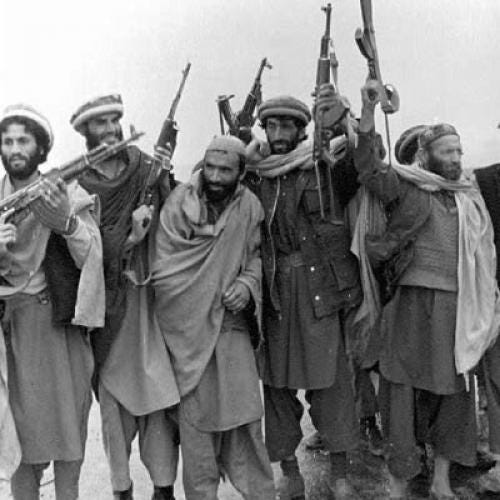
Mujahideen Guerrilla Tactics
Share
Mujahideen Guerrilla Tactics
How did the Afghan guerrillas manage to resist and eventually defeat the Soviet army that invaded their country in 1979? What were the tactics and weapons that they employed in their long and bloody struggle? And what were the impacts and consequences of their victory for Afghanistan and the world? Let's find out.
The Soviet invasion of Afghanistan was a long armed conflict that lasted from 1979 to 1989. The Soviet Union intervened in support of the Afghan communist government that had come to power in a coup in 1978. The coup had sparked a popular uprising among the majority of the Afghan population, who were mostly rural, conservative, and devout Muslims. The rebels, who called themselves mujahideen, meaning "holy warriors", fought to overthrow the communists and restore the Islamic law and traditional culture of their country. The mujahideen were supported by several countries, especially the United States, Pakistan, Saudi Arabia, and China, who saw the Soviet intervention as a threat to their own interests and influence in the region.
The mujahideen faced a formidable enemy in the Soviet army, which was one of the largest and most powerful in the world at the time. The Soviets had more than 100,000 troops, equipped with tanks, helicopters, jets, artillery, and chemical weapons. The mujahideen, on the other hand, had no regular army, no air force, no heavy weapons, and no central command. They were a loose coalition of different factions, tribes, and ethnic groups, with varying degrees of ideological, political, and religious views. They relied mostly on small arms.... rifles, pistols, and RPGs, that they either captured from the Russians, smuggled from other countries, or made locally.
So how did the mujahideen manage to fight against these odds?
The answer lies in their use of guerrilla warfare. The mujahideen used their knowledge of the terrain, their mobility, their stealth, and their surprise to harass and weaken the Soviet forces, while avoiding direct confrontation and battles. They also used their network of supporters, sympathizers, and informers in the local population to gather intelligence, get supplies, and recruit new fighters.
Some of the main tactics that the mujahideen used in their guerrilla warfare were:
- Ambushes: The mujahideen would set up traps and hidden positions along the roads, passes, and valleys that the Soviet convoys and patrols used. They would then attack them with small arms, rockets, and mines, inflicting casualties and damage, and then retreat quickly before the enemy could react or reinforce. The mujahideen also used ambushes to capture weapons, ammunition, and vehicles from the Soviets, which they then used against them in future attacks.
- Raids: The mujahideen would launch surprise attacks on Soviet bases, outposts, and installations, especially at night or during bad weather. They would use stealth, speed, and shock to overwhelm the enemy, destroy their equipment and facilities, and free their prisoners. They would then withdraw rapidly, taking advantage of the darkness or the terrain to evade pursuit.
- Sabotage: The mujahideen would target the Soviet infrastructure and communication systems, such as bridges, pipelines, power lines, radio stations, and radar sites. They would use explosives, rockets, or fire to disable or destroy them, disrupting the enemy's supply, mobility, and coordination. They would also plant mines and booby traps along the roads and trails, causing casualties and fear among the Soviet troops and vehicles.
- Propaganda: The mujahideen would use various means to spread their message and influence among the Afghan people and the world. They would use leaflets, posters, graffiti, radio broadcasts, and cassette tapes to inform, educate, and mobilize the population, and to expose the atrocities and corruption of the Soviet and communist forces. They would also use videos, photos, and interviews to document their victories and achievements, and to appeal for support and sympathy from the international community.
The mujahideen's guerrilla warfare proved to be very effective and successful against the Soviet forces, who were not prepared or trained for such a type of war. The Soviets suffered heavy losses in men, material, and morale, and were unable to secure or control the vast and rugged territory of Afghanistan. The mujahideen, on the other hand, gained confidence, experience, and reputation, and were able to sustain and expand their resistance. The war became a quagmire and a nightmare for the Soviet Union, which was already facing economic and political problems at home and abroad. The war also became a catalyst and a symbol for the global and regional struggle between the communist and the capitalist blocs, and between the secular and the religious forces.
The war ended in 1989, when the Soviet Union withdrew its troops from Afghanistan, following a peace agreement brokered by the United Nations. The withdrawal was seen as a humiliating defeat and a major blow for the Soviet superpower, which soon collapsed in 1991. The war also had profound and lasting impacts and consequences for Afghanistan and the world. The war left Afghanistan devastated, impoverished, and traumatized, with millions of dead, wounded, and displaced people. The war also created a power vacuum and a civil war, as the different mujahideen factions fought among themselves for control of the country. The war also gave rise to new and radical groups, such as the Taliban and al-Qaeda, who emerged from the ranks of the mujahideen and who would later pose new threats and challenges to the region and the world.
